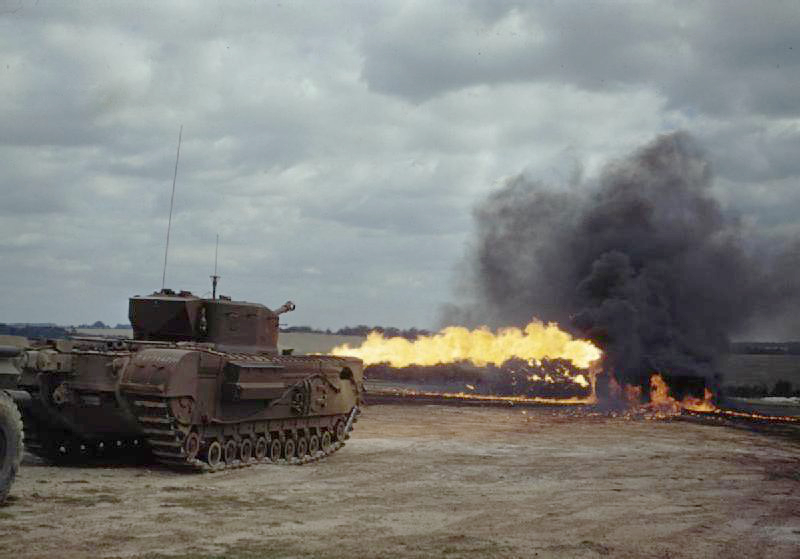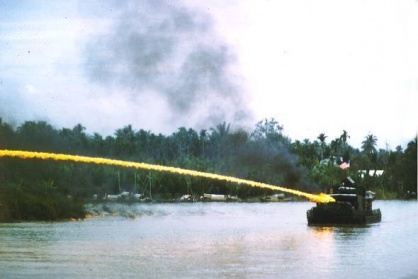Incendiary weapons
Contents
Description
The Flamethrower is a fire-based weapon added in Update "Fire and Ice" with rewards in the Battle Pass: Season IX, "Smell of Victory". These usually have a relatively short range with the ability to damage open-topped vehicles.
Vehicles equipped with this weapon
Ground Vehicles
The flamethrower on the Churchill Crocodile consists of a fuel trailer towed behind the tank and a flame projector in the bow gun position.
The LCM(6)(F) Zippo has two flamethrowers on the port and starboard sides behind the 40mm gun turret. This weapon system has fuel tanks located in the hull and projectors in small combined turrets paired with 7.62 mm M73 machine guns.
General info
Available ammunition
Flamethrowers use ignited liquid fuel as ammunition, usually consisting of a mixture of napalm similar to that used in incendiary bombs such as the BLU-1. The Churchill Crocodile uses a mixture called Fuel K, or FTF, Heavy No.1. There is currently no alternative fuel choices for the flamethowers in-game.
As an unconventional ammunition type, burning fuel has no armor penetration values and will not damage the internal modules of a vehicle if it is fully armored or CBRN-secured. If a vehicle is open-topped or very lightly armored with gaps, the flamethrower can output a devastating amount of damage.
Flamethrowers can output a type of damage that no other weapon system in the game can do, called Damage over Time. Ground areas, items, and enemy targets will continue to burn for a brief period after being hit. This can cause damage to the enemy even after the flamethrower has stopped firing.
Comparison with analogues
As unique weapon system, the flamethrower mounted on the Churchill Crocodile and the LCM(6)(F) Zippo have no comparable weapons in their respective gamemodes as of Update "Apex Predators".
Usage in battles
Ground Vehicles
Churchill Crocodile
As the flamethrower is unable to penetrate fully armored vehicles, it is ineffective damage-wise against most tanks that a player will encounter. Due to the weight of fuel, flamethowers can only hit targets at relatively short ranges.
However, this weapon is particularly useful for eliminating exposed crew members in open-topped vehicles and SPAA. For example, if a Churchill Crocodile shot flames at a Pz.IV H, it would take no damage. A Sd.Kfz. 6/2, however, would be burnt down within a few seconds.
This weapon is located in the bow gun position, replacing the machine gun mounted in the regular Churchill VII. As such, it has a very limited traverse and is dependent on the hull position for horizontal targeting. Vertical guidance is quite good, which can allow it to reach targets at short ranges outside of point-blank. Unfortunately, the slow speed of the Crocodile can make it difficult to get within range, so players will need to use the vertical limit to 'lob' shots onto the enemy.
In attacking enemies that are fully armored, a Churchill Crocodile can use its flamethrower to temporarily blind or distract the enemy. Fully armored vehicles can be shot with flames to blind and confuse them which can allow the Crocodile to shoot back or reposition itself. Fire can serve as a deterrent to vehicles with exposed crew from getting too close, something that can be problematic for a Churchill tank.
It should be noted that since this weapon is very specific, enemies will know a Churchill Crocodile is around when the flamethrower is used. When it is not in use, the fuel trailer is a major indicator of the vehicle. If this fuel tank is destroyed, it will explode. The tank crew will be unharmed, but the weapon system will be rendered unusable.
LCM(6)(F) Zippo
Flamethrowers are a very unique weapon in naval battles and can even burn the ocean surface. The system mounted to the LCM(6)(F) Zippo has long range for a flamethrower, but are very short-ranged in terms of naval weapons.
Like the Churchill Crocodile, one of this weapon system's disadvantages is being mounted to a vehicle that cannot quickly close the gap between it and the enemy to get within range. If they do, however, they can make quick work of small vessels with open gun positions. Larger vessels hit by the flamethrowers can be distracted by the fires, as they can be deadly if left uncontrolled.
This system is bound to the Anti-Aircraft suite when the player wants to manually control the weapons. Unfortunately, flamethrowers do not have the traverse speed or range to effectively combat enemy aircraft. Like other naval weapons, flamethrowers will elevate so that they can reach their effective ranges but with the dual mount, the M73 machine guns will be elevated the same. This means that while the flamethrowers can get on target, the machine guns will be elevated to such a degree that they become virtually unusable since bullet drop differ significantly from the fire arc.
Pros and cons
Pros:
- Very high damage output against exposed crewmembers
- Very high rate of fire (stream is constant as long as the weapon is firing)
- Fire can temporarily blind or distract enemy targets
- Can deter enemy open-topped vehicles
- Fire can be used to burn down vegetation
- Targets hit by flames will continue to burn for a brief period
Cons:
- No penetration to damage enclosed fully armored ground vehicles
- Limited firing arcs in hull mounts
- Short range
- Ammunition is lost if fuel tanks are destroyed
- The Churchill Crocodile and LCM(6)(F) Zippo can be slow to bring enemies within range of the flamethrowers
- Flamethrowing can attract unwanted attention to the projecting vehicle
History
Churchill Crocodile
With the First World War bringing about the development of the tank and the flamethrower, different nations would devise ways to combine the two into a single weapon system during the interwar period. A mobile armored flamethrower would allow the short-ranged weapon system to get close to the enemy with minimal risk from small-arms fire.
In Britain, efforts by the Petroleum Warfare Department (PWD), Associated Equipment Company (AEC), and Ministry of Supply (MoS) would lead to the development of a flamethrower tank based on the Churchill infantry tank family.
This would be completed in the form of an fuel trailer towed behind the Churchill with lines connecting to a flame projector mounted in place of the bow machine gun. The trailer was lightly armored and could resist light small-arms fire. If the trailer was destroyed or ran out of fuel, the crew could jettison it safely from the inside of the tank.
Churchill Crocodiles began service in the European Theatre in 1944 as part of specialized support units. The flamethrowers served as a potent psychological weapon as well, with many German troops choosing to surrender instead of being burned to death. They were deemed effective, despite their short range.
Crocodiles would go on to serve in the Korean War alongside other Churchill tanks until they were withdrawn from service in 1951.
LCM(6)(F) "Zippo"
Many WWII-surplus LCMs (Landing Craft, Mechanized) were modified by the Mobile Riverine Force in Vietnam as "monitor" patrol craft.
Flamethrowers were added to the LCM(6) which increased the offensive capabilities of the vessel, giving it the ability to clear vegetation and burn out enemy positions by the riverside. These flamethrowers gave the vessel the "Zippo" nickname, after a popular brand of cigarette lighters.
Media
See also
Ground Vehicles that use flamethrowers
Naval Vehicles that use flamethrowers





